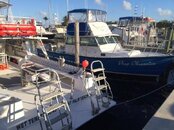So if you were on a charter boat like this one in South florida.....how would you get in the water quickly from being at the bench sitting, to being told to move to the platform with 3 to 4 other divers in a wave being dropped....say with there being 3 waves that would get separate drops to the same bottom site....and when your wave of divers is up, you each move up to the platform, and then jump in on the DIVE, DIVe DIVE command....You might be standing on the platform for 20 seconds to 2 minutes, as the boat runs a course to provide you with the perfect drop point for you trajectory to the bottom site desired. When the Dive command is given, a GOOD diver is in the water the instant the Word is out of the captain's mouth.....and should be 20 feet down and moving down at a good pace in a couple of seconds from the command being given....ideally, you are already swimming down, the moment you hit the water....Easy if you can dive in with your chin tucked, or if you do a giant stride with a 180 degree twist to back flop on entry, then with negative entry you can be swimming down from instant one after impact with water. Bad form, is any kind of giant stride where you pop back up after impact with the water, then need to do ANYTHING on the surface other than get head down and feet pushing you down

/QUOTE]
This is exactly what I've been practicing... albeit not on a boat.
Thus far I've been sitting between the two tanks and getting everything clipped and bungied. The problem is it takes being a contortionist to get everything clipped and bungied in that position..... but from stand up, stride, descend there is no pause to do anything.
I've been working on that because I know the boat dives are coming up, I know I do not like doing them that way. not with green eggs and ham, not with sam I am.





